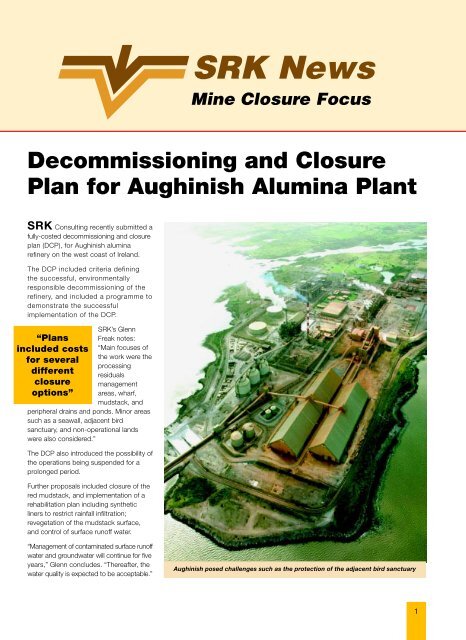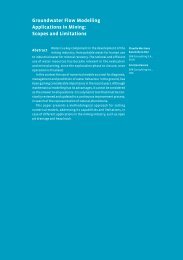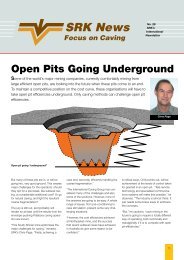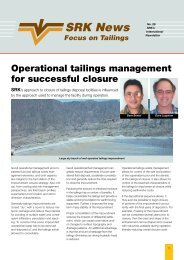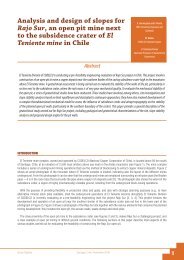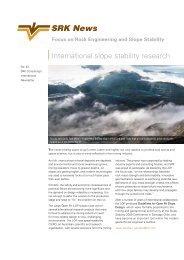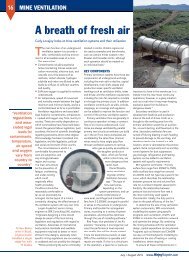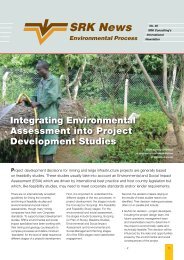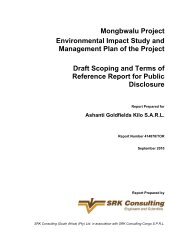Decommissioning and Closure Plan for Aughinish ... - SRK Consulting
Decommissioning and Closure Plan for Aughinish ... - SRK Consulting
Decommissioning and Closure Plan for Aughinish ... - SRK Consulting
Create successful ePaper yourself
Turn your PDF publications into a flip-book with our unique Google optimized e-Paper software.
Mine <strong>Closure</strong> Focus<br />
<strong>Decommissioning</strong> <strong>and</strong> <strong>Closure</strong><br />
<strong>Plan</strong> <strong>for</strong> <strong>Aughinish</strong> Alumina <strong>Plan</strong>t<br />
<strong>SRK</strong> <strong>Consulting</strong> recently submitted a<br />
fully-costed decommissioning <strong>and</strong> closure<br />
plan (DCP), <strong>for</strong> <strong>Aughinish</strong> alumina<br />
refinery on the west coast of Irel<strong>and</strong>.<br />
The DCP included criteria defining<br />
the successful, environmentally<br />
responsible decommissioning of the<br />
refinery, <strong>and</strong> included a programme to<br />
demonstrate the successful<br />
implementation of the DCP.<br />
“<strong>Plan</strong>s<br />
included costs<br />
<strong>for</strong> several<br />
different<br />
closure<br />
options”<br />
<strong>SRK</strong>’s Glenn<br />
Freak notes:<br />
“Main focuses of<br />
the work were the<br />
processing<br />
residuals<br />
management<br />
areas, wharf,<br />
mudstack, <strong>and</strong><br />
peripheral drains <strong>and</strong> ponds. Minor areas<br />
such as a seawall, adjacent bird<br />
sanctuary, <strong>and</strong> non-operational l<strong>and</strong>s<br />
were also considered.”<br />
The DCP also introduced the possibility of<br />
the operations being suspended <strong>for</strong> a<br />
prolonged period.<br />
Further proposals included closure of the<br />
red mudstack, <strong>and</strong> implementation of a<br />
rehabilitation plan including synthetic<br />
liners to restrict rainfall infiltration;<br />
revegetation of the mudstack surface,<br />
<strong>and</strong> control of surface runoff water.<br />
“Management of contaminated surface runoff<br />
water <strong>and</strong> groundwater will continue <strong>for</strong> five<br />
years,” Glenn concludes. “Thereafter, the<br />
water quality is expected to be acceptable.”<br />
<strong>Aughinish</strong> posed challenges such as the protection of the adjacent bird sanctuary<br />
1
Recovering<br />
‘Locked-up’<br />
Gold During<br />
<strong>Closure</strong><br />
Natural gravitation of gold to the<br />
lowest points in a gold processing<br />
plant may result in significant<br />
concentrations over a period of time.<br />
This, coupled to the process<br />
inventory, yields precious metal (lockup)<br />
value during the closure phase of<br />
a gold processing plant.<br />
“Locked-up” gold typically becomes<br />
available during initial<br />
decommissioning, covering the final<br />
cleaning operations; <strong>and</strong> postdemolition,<br />
when the foundation<br />
material can be reclaimed.<br />
The actual amount recovered<br />
depends on historical criteria<br />
including plant design, integrity of<br />
operations, housekeeping <strong>and</strong> head<br />
grade. However, the actual<br />
processing of the gold-bearing<br />
materials may pose their own<br />
challenges.<br />
Steve Hordley, Principal Process<br />
Engineer comments: “The financial<br />
benefits of recovery may be<br />
augmented by the managed disposal<br />
of assets. As with many other<br />
processes, maximisation of recovery<br />
<strong>and</strong> disposal requires effective<br />
planning <strong>and</strong> implementation in welldesigned,<br />
systematic, safe <strong>and</strong> costeffective<br />
closure.”<br />
“Recovery of gold from final closure<br />
is a highly inexact science, <strong>and</strong> there<br />
are no guarantees about the quantity<br />
of material recovered,” concludes<br />
Steve. “What is certain is that closure<br />
must be undertaken <strong>and</strong> that<br />
recovered gold, together with the<br />
managed disposal of assets, could<br />
go some distance towards funding<br />
the final site rehabilitation.”<br />
2<br />
Closing the East German<br />
Uranium Mining Industry<br />
Estimates of closure <strong>and</strong> reclamation costs are in the billions<br />
Wismut GmbH, <strong>for</strong>merly a joint Russian-<br />
East German uranium producer <strong>and</strong> now<br />
owner of the world’s largest mine closure<br />
project, has been a beneficiary of <strong>SRK</strong><br />
consulting expertise since 1992.<br />
With remediation of mining <strong>and</strong><br />
processing facilities a top environmental<br />
priority of the unified German<br />
government, Wismut estimates the total<br />
costs of closing <strong>and</strong> reclaiming its<br />
operations in the billions of dollars.<br />
<strong>SRK</strong>’s involvement began with a 1992-93<br />
study of the options <strong>for</strong> controlling<br />
groundwater flow through underground<br />
workings in the Ronneburg area. <strong>SRK</strong><br />
subsequently was retained to investigate<br />
options <strong>for</strong> remediating waste rock. The<br />
associated environmental concerns<br />
include acid generation, leaching of<br />
uranium, sulphate <strong>and</strong> metals, <strong>and</strong> radon<br />
emission. <strong>SRK</strong> recommended a program<br />
of selective relocation of rock to the<br />
Lichtenberg open pit.<br />
In 1995-96, <strong>SRK</strong> helped Wismut set up a<br />
laboratory testing facility, develop field<br />
methods <strong>for</strong> waste rock ‘grade control’,<br />
<strong>and</strong> recommend methods <strong>for</strong> block<br />
modeling <strong>and</strong> scheduling of the waste<br />
rock relocation. <strong>SRK</strong> also assisted<br />
Wismut’s decision-making about<br />
remediation measures <strong>for</strong> the remaining<br />
fourteen waste rock piles in the<br />
Ronneburg district.<br />
In 1996 <strong>and</strong><br />
1997, attention<br />
shifted to the<br />
Nordhalde, the<br />
second largest<br />
remaining waste<br />
rock pile at the<br />
Ronneburg site.<br />
Daryl Hockley<br />
<strong>SRK</strong> assisted in<br />
the design of a<br />
borehole gas <strong>and</strong> temperature monitoring<br />
system, <strong>and</strong> carried out detailed analysis<br />
of the data to estimate oxidation rates.<br />
<strong>SRK</strong> also provided conceptual designs<br />
<strong>and</strong> cost estimates <strong>for</strong> remediation<br />
measures.<br />
<strong>SRK</strong>’s recent work in the Ronneburg area<br />
has included an audit of the ongoing<br />
waste rock relocation, <strong>and</strong> assistance<br />
with testing of cover designs <strong>for</strong> the<br />
backfilled Lichtenberg pit.<br />
<strong>SRK</strong>’s Daryl Hockley <strong>and</strong> John Chapman<br />
have led <strong>SRK</strong>’s contribution to the<br />
Wismut project.<br />
Says Daryl: “Our work has been equal<br />
parts consulting <strong>and</strong> technology transfer.<br />
Initially the transfer was unidirectional, but<br />
the scale of the project is such that we<br />
now learn as much as we teach. Some of<br />
the precedents set by Wismut will be the<br />
st<strong>and</strong>ard <strong>for</strong> mine closure activities in the<br />
21st century.”
<strong>SRK</strong>, through its long-st<strong>and</strong>ing ties<br />
with the Kennecott Ridgeway Mine in<br />
South Carolina, has helped make this<br />
mine a prime example of successful<br />
design <strong>and</strong> operation <strong>for</strong> closure.<br />
“From the prefeasibilty stage of design,<br />
strong emphasis was given to the need to<br />
minimise the actual <strong>and</strong> contingent<br />
liability associated with operations <strong>and</strong><br />
closure,” explains Rob Dorey, <strong>SRK</strong><br />
Corporate Consultant. “<strong>Closure</strong> planning<br />
has been periodically updated throughout<br />
the mine life, with the detail of the plan<br />
increasing as closure approached.”<br />
“The potentially acid generating (PAG)<br />
nature of the host rock of this epithermal<br />
deposit required the adoption of proactive<br />
waste rock management. Use of<br />
the waste rock in construction of the<br />
tailings impoundment, with compaction<br />
Design <strong>and</strong> Operation <strong>for</strong> <strong>Closure</strong><br />
at Kennecott Ridgeway<br />
<strong>and</strong> encapsulation of PAG waste rock,<br />
was incorporated in the design. The<br />
phased development of the two pits also<br />
allowed the partial backfilling of one pit<br />
during mining of the other.”<br />
As part of the closure planning, <strong>SRK</strong> has<br />
per<strong>for</strong>med a number of studies. These<br />
include a surface water mixing <strong>and</strong> water<br />
quality model, project-wide groundwater<br />
<strong>and</strong> contaminant transport model <strong>and</strong><br />
tailings cover model. A detailed evaluation<br />
of the methods <strong>and</strong> viability of achieving<br />
long-term closure was also completed.<br />
The presence of PAG material in the pit<br />
walls required the management of both<br />
backfill material <strong>and</strong> water used to flood<br />
the pit. “Lime softening has been used,<br />
with a target alkalinity of the pit water to<br />
buffer acid generated by the pit walls <strong>and</strong><br />
backfill <strong>and</strong> contact runoff water from<br />
the site,” Rob<br />
exp<strong>and</strong>s. “To close<br />
the tailings<br />
impoundment, a<br />
modification of the<br />
deposition system<br />
to regrade the<br />
impoundment<br />
surface to create<br />
positive drainage<br />
was adopted.”<br />
“With a net positive water balance at<br />
closure, the need to rapidly cover the<br />
tailings was accommodated by placing<br />
the cover as a slurry, using the existing<br />
tailings deposition system. To date all<br />
indications are that per<strong>for</strong>mance criteria<br />
<strong>for</strong> the closure are being met.”<br />
Framework <strong>for</strong> Coal Mine <strong>Closure</strong> in Bulgaria<br />
<strong>SRK</strong> <strong>Consulting</strong> recently completed its<br />
contribution to new guidelines <strong>for</strong> closure of<br />
underground coal mines in Bulgaria, a<br />
European Commission-funded PHARE<br />
project covering socio-economic, technical,<br />
safety <strong>and</strong> environmental issues.<br />
Pilot closure programmes were developed<br />
<strong>for</strong> two mines in contrasting socioeconomic<br />
<strong>and</strong> environmental settings:<br />
Pernik, in a heavily industrialised city, <strong>and</strong><br />
Pirin in a remote mountain location.<br />
Piers Sadler remarks: “The approach taken to<br />
environmental aspects was through risk<br />
assessment <strong>and</strong> risk control carried out in<br />
parallel with staged site investigation.”<br />
“Complex issues included restitution of stateowned<br />
l<strong>and</strong> to its pre-communist owners,<br />
<strong>and</strong> reconciling existing Bulgarian legislation<br />
with EC environmental requirements.”<br />
Ab<strong>and</strong>oned surface facilities at the Pirin Mine<br />
Rob Dorey<br />
3
<strong>SRK</strong> Consultant<br />
Profile:<br />
Julie Glavin<br />
4<br />
Julie Glavin<br />
Julie Glavin joined the <strong>SRK</strong> Tucson<br />
office in early 1999. Julie brings over<br />
10 years of mining <strong>and</strong> civil/<br />
construction experience, primarily in<br />
environmental engineering <strong>and</strong><br />
compliance. As a senior engineer in<br />
the Tucson office, she is currently<br />
engaged in the development of a<br />
comprehensive closure program <strong>for</strong><br />
an existing mining client.<br />
This particular project features<br />
contributions from <strong>SRK</strong> technical<br />
specialists from around the world.<br />
Julie also provides specialized<br />
consulting services related to the<br />
Clean Water Act, National<br />
Environmental Policy Act <strong>and</strong><br />
wetl<strong>and</strong>s mitigation work.<br />
Proactive Operating Procedures<br />
Reduce Future <strong>Closure</strong> Liability<br />
An extensive <strong>SRK</strong> project to manage<br />
oxidisation-prone residual sulfides in the<br />
tailings impoundment at Thompson Creek<br />
Mine in central Idaho is set to pay future<br />
dividends in the <strong>for</strong>m of significantly<br />
reduced costs <strong>and</strong> liability.<br />
Situated in the Salmon River drainage,<br />
Thompson Creek processes up to 32 000<br />
tpd of molybdenum ore. The tailings<br />
impoundment at the project uses a<br />
centerline construction technique<br />
employing cycloned s<strong>and</strong> to construct<br />
the embankment.<br />
The impoundment, designed by <strong>SRK</strong> in<br />
the early 1980s, is planned to reach an<br />
ultimate height of 720 ft from toe to crest.<br />
In 1990, residual sulfides in the tailings<br />
product were identified as having a<br />
potential to oxidize. Of the options<br />
considered to alleviate the impact of this<br />
Mine <strong>Closure</strong> Workshop<br />
Advances the State of the Art<br />
In October 1998, eighteen of <strong>SRK</strong>’s<br />
senior engineers <strong>and</strong> scientists met in<br />
Vancouver <strong>for</strong> a mine closure workshop.<br />
The objectives were to crystallize <strong>and</strong><br />
synthesize <strong>SRK</strong>’s experience in closure<br />
projects, <strong>and</strong> map out areas of relevant<br />
expertise.<br />
Participants came from <strong>SRK</strong> offices in South<br />
America, Africa <strong>and</strong> the UK, as well as<br />
Denver, Reno, Elko, Tucson <strong>and</strong> Vancouver.<br />
Products of the workshop include several<br />
papers on various areas of expertise, <strong>and</strong><br />
a website featuring a ‘knowledge map’<br />
that charts the relationships between<br />
technical disciplines <strong>and</strong> project objectives.<br />
oxidation, use of a secondary flotation<br />
process to produce a pyrite concentrate<br />
was selected. In this process, the sulfide<br />
content of the tailings is reduced to a<br />
level at which oxidation is not predicted<br />
to significantly impact drainage water<br />
quality.<br />
To dispose of the pyrite concentrate, a<br />
separate delivery system was designed to<br />
allow placement of the material within the<br />
saturated slimes zone of the<br />
impoundment. This ‘subaqueous’<br />
environment alleviates the potential of<br />
oxidation of the pyrite.<br />
<strong>SRK</strong>’s Rob Dorey remarks: “This<br />
proactive step by Thompson Creek has<br />
reduced the contingent liability of closure<br />
of the impoundment by the adoption of<br />
operating procedures to facilitate ultimate<br />
closure.”<br />
Workshop organiser Daryl Hockley<br />
elaborates: “Most of our clients do not<br />
have a lot of mine closure experience. But<br />
in <strong>SRK</strong> we have over 20 people who have<br />
each worked on at least a dozen closure<br />
projects.”<br />
“We thought that if we could get most of<br />
those people together, we could<br />
significantly advance the state of the art.<br />
The challenge is to create a systematic<br />
approach, while at the same time<br />
respecting the variety of project needs.”
Peter Labrum<br />
Thorough groundwork done by an <strong>SRK</strong><br />
team at Rossing mine in Namibia in July<br />
1995 has allowed mine personnel to carry<br />
out in-house updates of probable closure<br />
costs <strong>and</strong>, as of 1996, maintain accurate<br />
records of surface asset replacement<br />
costs <strong>for</strong> insurance <strong>and</strong> other purposes.<br />
During the initial visit <strong>SRK</strong> staff spent time<br />
with all relevant mine personnel to ensure<br />
that a comprehensive database of closure<br />
costs was compiled. Extensive use was<br />
made of surface layout plans of the mine,<br />
<strong>and</strong> the database was cross-referenced<br />
to the plans.<br />
Digital Database Eases <strong>Closure</strong> Costing &<br />
Surface Assets Evaluation at Rossing Mine<br />
Rossing Mine showing part of the open pit<br />
“A rates build-up was supplied <strong>for</strong> most<br />
items,” recalls Peter Labrum, Principal<br />
Engineer. “This was linked to the main<br />
database, enabling the costing to be<br />
updated by simply changing key<br />
parameters in the rates. The final<br />
product was supplied to the mine in<br />
digital <strong>for</strong>m, enabling them to carry out<br />
the updates in-house.”<br />
In December 1996 <strong>SRK</strong> completed a<br />
detailed schedule of surface asset<br />
replacement costs to enable the mine to<br />
check its insurance portfolio.<br />
“Due to the detailed schedules produced<br />
during the closure costing study, the<br />
replacement cost schedules could be<br />
quickly <strong>and</strong> efficiently produced in a similar<br />
updatable digital <strong>for</strong>mat,” says Peter.<br />
5
UN Taps <strong>SRK</strong><br />
<strong>for</strong> Omai Gold<br />
Mine <strong>Closure</strong><br />
Review<br />
In the wake of the failure of Tailings<br />
Dam #1 at Omai Gold Mine, Dr.<br />
Geoff Ricks of <strong>SRK</strong> <strong>Consulting</strong> was<br />
recently appointed through the<br />
United Nations Development<br />
Programme (UNDP) to independently<br />
review the mine closure plans <strong>and</strong><br />
implementation.<br />
As the Specialist International<br />
Consultant on behalf of the<br />
Government of Guyana<br />
Environmental Protection Agency<br />
(EPA), Geoff’s brief was to technically<br />
review the plans, <strong>and</strong> define a<br />
structure within which EPA <strong>and</strong> Omai<br />
Gold Mines could implement the<br />
closure plans. In addition<br />
recommendations were to be made<br />
to strengthen the EPA’s effectiveness<br />
in regulating the mining operations.<br />
Geoff comments: “The final report<br />
included a programme of<br />
environmental monitoring, equipment<br />
<strong>and</strong> training of officers who will be<br />
involved in monitoring <strong>and</strong> evaluating<br />
environmental impacts.”<br />
“Other key aspects included<br />
recommendations on environmental<br />
obligations to be imposed on the<br />
company, provisions <strong>for</strong> minimising<br />
environmental damage during<br />
closure implementation <strong>and</strong> methods<br />
of providing financial sureties”.<br />
6<br />
Geoff Ricks<br />
Edmondsley & Fender Minewater<br />
Discharge Remediation<br />
The Edmondsley wetl<strong>and</strong> uses reeds to filter metals which precipitate from the water<br />
The British Coal Authority<br />
commissioned <strong>SRK</strong><br />
<strong>Consulting</strong> to undertake<br />
feasibility studies <strong>and</strong> detailed<br />
designs <strong>for</strong> minewater<br />
remediation at the<br />
Edmondsley & Fender <strong>for</strong>mer<br />
colliery sites, ranked among<br />
the most polluting in Engl<strong>and</strong>.<br />
Piers Sadler, responsible <strong>for</strong><br />
discharge characterisation<br />
<strong>and</strong> wetl<strong>and</strong> designs,<br />
comments: “The Edmondsley scheme<br />
involves pumping minewater at 4 l/sec to<br />
Piers Sadler<br />
“treatment<br />
remediates<br />
one of the<br />
most polluting<br />
sites in<br />
Engl<strong>and</strong>”<br />
a 0.4 ha wetl<strong>and</strong> treatment<br />
area, within a wildlife<br />
conservation zone providing<br />
educational <strong>and</strong> recreational<br />
facilities.”<br />
“The Fender scheme involves<br />
a pipeline river crossing <strong>and</strong> a<br />
wetl<strong>and</strong> of about 0.6 ha area.”<br />
<strong>SRK</strong> was subsequently<br />
awarded a third feasibility<br />
study <strong>and</strong> detailed design<br />
study <strong>for</strong> the treatment of minewater<br />
discharge at Blaenavon in South Wales.
Combined <strong>Closure</strong> <strong>Plan</strong> <strong>and</strong> EIA Report<br />
<strong>for</strong> Copper Project<br />
<strong>SRK</strong> recently completed a fully-costed<br />
closure plan <strong>and</strong> EIA report <strong>for</strong> a<br />
confidential client seeking mining<br />
approval <strong>for</strong> a proposed underground<br />
copper mine in Western Europe.<br />
The deposit, consists of 14.3 Mt of highgrade<br />
massive sulphide ore located within<br />
a sensitive rural environment. Key closure<br />
issues included tailings disposal, reinstatement<br />
of agricultural l<strong>and</strong> <strong>and</strong><br />
treatment of post-mining metal <strong>and</strong> acidcontaminated<br />
mine water.<br />
Glenn Freak, Senior Environmental<br />
Scientist, comments: “In response to the<br />
strict environmental legislation in Europe<br />
<strong>and</strong> the environmental concerns at the<br />
project site, tailings disposal centred on a<br />
Don’t Underestimate <strong>Closure</strong> Liabilities<br />
When Valuing Mining Properties<br />
Clients involved in mergers, acquisitions,<br />
share offerings <strong>and</strong> other transactions<br />
often underestimate the importance of<br />
closure costs in the overall valuation of<br />
mining properties.<br />
Examples of closure liabilities recently<br />
assessed by <strong>SRK</strong>’s Vancouver office<br />
range from US$750 000 <strong>for</strong> an advanced<br />
exploration site with minimal water quality<br />
impacts to US$30-million net present<br />
value <strong>for</strong> a mine site with a requirement to<br />
collect <strong>and</strong> treat acidic water.<br />
paste backfill plant to return<br />
tailings underground, operating in<br />
t<strong>and</strong>em with an engineered<br />
repository to store dewatered<br />
tailings on surface.”<br />
“The design minimises the reduced<br />
surface area required <strong>for</strong> disposal,<br />
restricts pyrite oxidation <strong>and</strong> allows<br />
progressive rehabilitation.”<br />
L<strong>and</strong> use will revert to agriculture once all<br />
site infrastructure is decommissioned,<br />
dismantled <strong>and</strong> removed. Pre-stripped<br />
topsoil, from stockpiles, will be spread on<br />
the re-contoured ground at closure. To<br />
protect the low permeability membrane<br />
cover on the repository, low-intensity<br />
grazing is proposed.<br />
“The process of estimating<br />
closure liabilities starts with a<br />
closure plan,” says Kelly<br />
Sexsmith of <strong>SRK</strong> <strong>Consulting</strong>’s<br />
GeoEnvironmental Engineering<br />
group.<br />
“We usually find that people at<br />
the mine site have clear ideas<br />
about closure issues <strong>and</strong><br />
possible closure measures. But<br />
they often haven’t had the time needed<br />
to pull those ideas together.”<br />
“Mine water investigations<br />
indicated that backfilled<br />
workings should be<br />
flooded as quickly as<br />
possible after mining by<br />
active water injection,”<br />
Glenn continues. “This<br />
creates an inward<br />
hydraulic gradient<br />
allowing water quality to<br />
be stabilised by re-circulation <strong>and</strong><br />
treatment over two to three years.”<br />
Glenn Freak<br />
<strong>Closure</strong> <strong>and</strong> rehabilitation cost estimate<br />
calculations <strong>for</strong> decommissioning,<br />
demolition, rehabilitation, after-care <strong>and</strong><br />
monitoring were made including<br />
provisions should premature closure<br />
occur.<br />
“Further, the quality of<br />
plans prepared to meet<br />
regulatory requirements<br />
is quite variable. Our job<br />
in a liability estimate is to<br />
quickly review closure<br />
issues <strong>and</strong> then focus on<br />
estimates <strong>for</strong> the most<br />
Kelly Sexsmith<br />
costly items. Given the<br />
limited time available <strong>for</strong><br />
these projects, our ability to quickly<br />
compare costs with experience elsewhere<br />
is critical.”<br />
7
What Goes Up… Must Come Down!<br />
Steve Hordley of <strong>SRK</strong> <strong>Consulting</strong><br />
was involved in the decommissioning<br />
of the President Br<strong>and</strong> Metallurgical<br />
Scheme, part of Freegold, in South<br />
Africa’s Free State.<br />
The plant re-treated gold tailings<br />
material, yielding sulphuric acid,<br />
uranium <strong>and</strong> gold. Uranium<br />
production ceased in 1990, the<br />
flotation, acid <strong>and</strong> gold operations<br />
continued until 1995.<br />
<strong>Decommissioning</strong> activities included<br />
inventory removal <strong>and</strong> radiological<br />
decontamination, asset removal <strong>and</strong><br />
final demolition, including demolition<br />
of the sulphuric acid pyrite roasters<br />
<strong>and</strong> stack, pictured here. The site is<br />
currently undergoing rehabilitation.<br />
8<br />
Steve Hordley<br />
Steve Hordley<br />
Experienced mine closure specialist<br />
Steve Hordley, joined <strong>SRK</strong> <strong>Consulting</strong>’s<br />
UK office in 1998 after some 18 years’<br />
work in metallurgical operations in South<br />
Africa involving production, closure<br />
planning <strong>and</strong> demolition activities. Steve<br />
has participated in numerous projects,<br />
including closure planning <strong>and</strong><br />
management of operations such as<br />
flotation, uranium, gold <strong>and</strong> sulphuric<br />
acid. He also has considerable expertise<br />
encompassing radiological<br />
decontamination, decommissioning,<br />
precious metal recovery <strong>and</strong> all aspects<br />
of related health <strong>and</strong> safety issues.
Black Pine Mine Heap Leach <strong>Closure</strong><br />
Black Pine Mining, Inc. (BPMI) contracted<br />
in 1995 with WESTEC, Inc. (whose operations<br />
were merged with <strong>SRK</strong> <strong>Consulting</strong> in 1998)<br />
to prepare a closure plan <strong>for</strong> their 34-million<br />
ton heap leach facility located in the southeastern<br />
corner of Idaho, USA. The heap, a<br />
valley fill design, had 50 million gallons of<br />
solution in process containing cyanide <strong>and</strong><br />
other constituents in concentrations greater<br />
than safe drinking water st<strong>and</strong>ards.<br />
Background data was collected to<br />
characterize the physical, geochemical, <strong>and</strong><br />
other environmental aspects of the heap.<br />
Solution treatment methodologies were<br />
researched <strong>and</strong> their respective costs<br />
evaluated. The results of this work were<br />
used to develop a risk assessment to<br />
address the potential impacts that the<br />
spent ore-solution system could have on<br />
the local environment. Black Pine Mining,<br />
Inc., stopped adding cyanide to the heap in<br />
January 1998 <strong>and</strong> began recirculating<br />
solution. Evaporation proved to be so<br />
effective that l<strong>and</strong> application of spent<br />
solution was not utilized. Further, the weakacid<br />
dissociable (WAD) cyanide level has<br />
been consistently declining <strong>and</strong> was projected<br />
to meet the 0.2 mg/l st<strong>and</strong>ard in March 1999.<br />
Other constituents previously occurring at<br />
concentrations greater than safe drinking<br />
water st<strong>and</strong>ards have also declined.<br />
“All in all,” said BPMI’s General Manager<br />
Crellin Scott, “closure activities at the mine<br />
proceeded at or better than projections.<br />
Advanced planning allowed us to proceed<br />
with a minimum of capital <strong>and</strong> operating<br />
outlay. This project demonstrates, among<br />
other things, that intensive solution<br />
management can<br />
shorten the pad<br />
closure time<br />
requirements, enhance<br />
gold recovery, reduce<br />
solution treatment<br />
costs <strong>and</strong> control the<br />
solution balance.”<br />
Val Sawyer<br />
“We interacted closely with BPMI to identify<br />
the most effective means of providing the<br />
best quality service while keeping costs<br />
down”, said Val Sawyer, <strong>SRK</strong> Principal<br />
Consultant. “We were able to work directly<br />
with BPMI technical <strong>and</strong> operating staff to<br />
collect samples, conduct metallurgical<br />
testing, analyze results, <strong>and</strong> then <strong>for</strong>m a<br />
long-term strategy.”<br />
9
<strong>SRK</strong>’s ‘Reverse<br />
Mining’ Experts<br />
<strong>SRK</strong>’s John<br />
Chapman <strong>and</strong><br />
Daryl Hockley are<br />
becoming<br />
experts in what<br />
they smilingly<br />
refer to as<br />
‘reverse mining’.<br />
Together, they<br />
have completed<br />
two major<br />
projects involving<br />
John Chapman<br />
the return of<br />
waste rock to<br />
mined-out pits. Kennecott’s Flambeau<br />
Mine in Wisconsin is now backfilled<br />
<strong>and</strong> reclaimed, <strong>and</strong> backfilling of<br />
Wismut’s Lichtenberg pit in Germany<br />
is about half completed.<br />
Pit backfilling raises a number of very<br />
practical questions. In both projects,<br />
the objective was to put the most acidgenerating<br />
material near the bottom of<br />
the pit, where it would subsequently be<br />
inundated with groundwater.<br />
The groundwater will prevent long<br />
term oxidation <strong>and</strong> acid generation,<br />
but will also release any acidity that<br />
has accumulated in the rock during its<br />
time on surface.<br />
<strong>SRK</strong>, as part of the 120 000-tpd<br />
earth-moving operation at Lichtenberg,<br />
<strong>and</strong> 80 000-tpd project at Flambeau,<br />
designed programs to sample waste<br />
rock during the relocation, measure<br />
both its current acidity <strong>and</strong> its future<br />
acid generation potential, <strong>and</strong> add<br />
appropriate amounts of alkalinity.<br />
“The resulting system of long-term<br />
planning, sampling, analysis, data<br />
review <strong>and</strong> short term planning was<br />
very similar to the procedures used to<br />
control open-pit mining,” says John.<br />
“Open pit mining engineers from <strong>SRK</strong>’s<br />
Vancouver mining group provided much<br />
of the required mining technology.”<br />
10<br />
<strong>Closure</strong> Sequence<br />
MINE FEASIBILITY<br />
INITIAL CLOSURE PLAN<br />
PROGRESSIVE REHABILITATION<br />
AND MONITORING<br />
INTERIM UPDATES OF<br />
CLOSURE PLAN<br />
FINAL CLOSURE PLAN<br />
MINE CLOSURE :<br />
DECOMMISSIONING<br />
DEMOLITION<br />
ACTIVE CARE<br />
REHABILITATION<br />
PASSIVE CARE<br />
REHABILITATION<br />
CLOSE-OUT REPORT<br />
This diagram, which outlines the phases<br />
of the closure sequence, is part of a<br />
proactive initiative by <strong>SRK</strong> <strong>Consulting</strong> to<br />
promote successful <strong>and</strong> effective mine<br />
closure planning <strong>and</strong> decision-making<br />
within a European context.<br />
Integral to the programme is a report, A<br />
Technical Framework <strong>for</strong> Mine <strong>Closure</strong><br />
<strong>Plan</strong>ning - Technical Review Series No.<br />
20, published by the British Mineral<br />
Industry Research Organisation (MIRO).<br />
Targeted mainly at the mining <strong>and</strong> mineral<br />
<strong>Closure</strong><br />
<strong>Plan</strong>ning<br />
STRATEGIC<br />
REVIEW FOR<br />
CLOSURE<br />
<strong>Closure</strong> <strong>Plan</strong><br />
Implementation<br />
CLOSE OUT<br />
AFTER USE RELEASE OF SITE<br />
processing industries <strong>and</strong> regulatory<br />
bodies, the framework is designed to<br />
assist in the preparation <strong>and</strong> evaluation of<br />
mine closure plans, providing an overview<br />
of mine closure practices.<br />
This invaluable reference is available <strong>for</strong><br />
purchase through MIRO <strong>for</strong> GBP 200 <strong>and</strong><br />
can be ordered by contacting Hazel<br />
Pexton, Secretary, MIRO,<br />
telephone: +44 (0) 1543 262957,<br />
fax: +44 (0) 1543 262183<br />
email: hsp@mirolich.demon.co.uk
Departure With Dignity – Ten Years Later<br />
<strong>SRK</strong> recently returned to the scene of<br />
a highly successful mine closure from the<br />
previous decade – the Beaverlodge<br />
uranium mine in Northern Saskatchewan.<br />
Beaverlodge was one of the first operations<br />
of its sort in the very productive<br />
Athabasca Basin. Its closure in 1986 was<br />
the subject of considerable investigation<br />
<strong>and</strong> careful design, later described in the<br />
book Departure with Dignity.<br />
Escondida Shows It’s Never Too Early to <strong>Plan</strong> <strong>Closure</strong><br />
Estimates of closing <strong>and</strong> reclamation are in the billions<br />
Though the Escondida deposit has<br />
reserves sufficient <strong>for</strong> an additional 40 to<br />
50 years of mining, Minera Escondida<br />
Limitada (MEL) is making plans now to<br />
regularly set aside funds <strong>for</strong> closing the<br />
mine <strong>and</strong> related facilities – an approach<br />
expected to pay significant dividends<br />
later.<br />
The Escondida deposit is 3 100 m above<br />
sea level in the Atacama desert of<br />
northern Chile. Mining started in late<br />
1990. Recent estimates put reserves at<br />
about 1 800-million tons of ore, with an<br />
average 1.59% copper. The current<br />
mining rate is about 127 000 tpd.<br />
<strong>SRK</strong>’s Cam Scott says: “In March 1997,<br />
we were contracted to develop a<br />
“Ten years later, <strong>SRK</strong> returned to the site<br />
to investigate ‘boils’ of radioactive tailings<br />
through a cover that had been applied<br />
during the reclamation” says Cam Scott<br />
of <strong>SRK</strong> Vancouver. “The cause was<br />
found to be a combination of hydraulic<br />
pressures <strong>and</strong> winter freezing of the cover<br />
<strong>and</strong> upper tailings.”<br />
<strong>SRK</strong> carried out design calculations <strong>and</strong><br />
field investigations to determine the cause<br />
decommissioning plan<br />
<strong>and</strong> cost estimate in<br />
association with the<br />
environmental<br />
department of MEL.”<br />
Cam Scott<br />
“The objectives were to<br />
provide a comprehensive list of mine<br />
facilities to be addressed at closure <strong>and</strong>,<br />
to the extent possible, identify the<br />
appropriate closure measure <strong>for</strong> each of<br />
these facilities.”<br />
“Where further in<strong>for</strong>mation or action was<br />
required to define the appropriate closure<br />
measure with a reasonable degree of<br />
confidence, we were tasked with<br />
specifying action(s) necessary to reduce<br />
the uncertainty to an acceptable level.”<br />
A decade<br />
after closure,<br />
reclamation<br />
<strong>and</strong><br />
remediation<br />
are exemplary<br />
of the problems, <strong>and</strong> recommended a<br />
number of remediation measures. <strong>SRK</strong><br />
was awarded the contract to supervise<br />
construction of the remediation measures<br />
during the summer of 1997. Follow up<br />
inspections in 1998 demonstrated the<br />
success of the work.<br />
The study indicated that the<br />
tailings facilities are likely to<br />
dominate the total closure cost,<br />
<strong>and</strong> that this cost could be<br />
significant.<br />
The closure plan will be<br />
periodically updated to reflect changes in<br />
the mine facilities, technology <strong>and</strong> the<br />
legal aspects of mine closure.<br />
“However, <strong>for</strong> now, MEL will use the plan<br />
as the basis <strong>for</strong> establishing regular<br />
funding allocations in preparation <strong>for</strong><br />
closure,” Cam reveals. “In the long term,<br />
this approach is expected to have highly<br />
positive implications <strong>for</strong> MEL in terms of<br />
closure quality <strong>and</strong> minimising eventual<br />
closure expenditures.”<br />
11
Closing Ab<strong>and</strong>oned Mines in the Canadian North<br />
<strong>SRK</strong>’s Vancouver office recently<br />
assisted Public Works & Government<br />
Services Canada (PWGSC) in<br />
implementing closure measures at four<br />
ab<strong>and</strong>oned mines in the Canadian North.<br />
The Rayrock Mine in the Northwest<br />
Territories was reclaimed by PWGSC in<br />
1996. Daryl Hockley <strong>and</strong> Rod Olauson<br />
inspected the site in June 1998 <strong>and</strong><br />
recommended minor upgrades <strong>and</strong><br />
maintenance.<br />
The same team reviewed plans <strong>for</strong> Phase<br />
I reclamation at the Discovery Mine, also<br />
in the Northwest Territories (NWT), in the<br />
winter of 1997-98. After his return from<br />
Santiago, Cam Scott joined the team,<br />
<strong>and</strong> is currently leading <strong>SRK</strong>’s review of<br />
the Phase II reclamation plans <strong>for</strong> Discovery.<br />
12<br />
Ab<strong>and</strong>oned tailings facility near Carcross, Yukon Territory<br />
Because of their remote location, heavy<br />
equipment can only reach Discovery <strong>and</strong><br />
Rayrock by ice roads, a common feature<br />
in the NWT. Constructed over frozen<br />
lakes <strong>and</strong> streams, ice roads often are<br />
associated with very high costs owing to<br />
requirements <strong>for</strong> winter mobilization,<br />
operation <strong>and</strong> demobilization be<strong>for</strong>e the<br />
spring thaw.<br />
The neighboring Yukon Territory is the site<br />
of two other <strong>SRK</strong>-PWGSC mine closure<br />
projects. The Venus Mine tailings facility<br />
was reclaimed in 1996, using a ‘Waterloo<br />
Barrier’, i.e. a grouted sheet pile wall<br />
used to cut off seepage. <strong>SRK</strong> reviewed<br />
the work in 1998 <strong>and</strong> recommended<br />
upgrades to ensure dam stability <strong>and</strong><br />
improve water cover.<br />
<strong>SRK</strong> inspected the Arctic Gold & Silver<br />
(AGS) tailings facility site in June 1998,<br />
<strong>and</strong> has since carried out a complete<br />
investigation <strong>and</strong> submitted<br />
recommendations <strong>for</strong> the closure work.<br />
Construction specifications are now being<br />
drawn up by PWGSC.<br />
“AGS is a good example of the<br />
challenges posed by ab<strong>and</strong>oned mine<br />
closures in the Yukon,” Daryl points out.<br />
“Issues that needed to be assessed<br />
included re-processing of the tailings,<br />
which might provide employment <strong>for</strong> the<br />
local First Nation <strong>and</strong>, on a completely<br />
different tack, the long term stability of a<br />
water retaining structure constructed by a<br />
beaver (Cam calculated the factor of<br />
safety to be just a little over one!)”
<strong>Closure</strong> Study <strong>for</strong> Cerro Do Lobo<br />
Tailings Impoundment<br />
The tailings is placed sub-aqueously behind a rockfill embankment<br />
Neves Corvo Copper Mine<br />
in Portugal is owned by<br />
Somincor, the state mining<br />
company, with Rio Tinto a<br />
minority shareholder. The<br />
pyritic tailings are deposited<br />
under water, to prevent acid<br />
generation.<br />
<strong>SRK</strong> was appointed to<br />
revise the tailings<br />
impoundment closure plan.<br />
Five different methods of<br />
operation <strong>and</strong> closure were considered,<br />
including combinations of disposal as a<br />
slurry or paste, deposition by subaqueous<br />
or sub-aerial methods, <strong>and</strong><br />
closure under a water cover or beneath a<br />
low-permeability cover.<br />
Ian Brackley<br />
The assessment of the<br />
preferred option was<br />
influenced by the desire to<br />
apply tried <strong>and</strong> trusted<br />
technology, by the need to<br />
prevent oxidation of the<br />
tailings, <strong>and</strong> by the need <strong>for</strong><br />
an environmentally-acceptable<br />
solution which minimised the<br />
long-term maintenance after<br />
closure.<br />
The closure study was<br />
followed by a risk analysis to determine<br />
the probability <strong>and</strong> consequences of<br />
tailings dam failure followed by a<br />
catastrophic flow slide, <strong>and</strong> to identify<br />
changes required to reduce the risk to an<br />
acceptable level.<br />
Mine <strong>Closure</strong><br />
Services<br />
‘Down Under’<br />
John Chapman<br />
In 1998, <strong>SRK</strong> transferred some of its<br />
North American mine closure<br />
expertise to Australia.<br />
Prior to moving to Australia, John<br />
Chapman, a chemical engineer, spent<br />
10 years working on mine closures in<br />
Canada, the U. S. <strong>and</strong> Europe.<br />
“Although mine closure regulations in<br />
many states of Australia are not as<br />
stringent as those of North America,<br />
many clients appreciate the<br />
perspective that comes from working<br />
with stricter environmental<br />
regulations,” says John. Most<br />
recently, Norm<strong>and</strong>y Mining Company<br />
has been taking advantage of John’s<br />
experience by having him review final<br />
closure plans <strong>for</strong> their Mt. Leyshon<br />
Mine in Queensl<strong>and</strong> <strong>and</strong> the<br />
Woodcutters Mine in the Northern<br />
Territory.<br />
13
Palabora’s <strong>Closure</strong> Database Saves Cost <strong>and</strong> Manpower<br />
Peter Labrum<br />
Early development of a database of<br />
probable closure costs <strong>for</strong> South Africa’s<br />
Palabora open pit mine provided a<br />
payback in subsequent years in the <strong>for</strong>m<br />
of reduced cost <strong>and</strong> manpower needed<br />
to update this key in<strong>for</strong>mation.<br />
The initial cost-estimate was completed in<br />
1993 by a multi-disciplinary <strong>SRK</strong> team led<br />
14<br />
Some of the infrastructure at Palabora Mine<br />
by Peter Labrum <strong>and</strong> Ritchie Stuart.<br />
They spent a week at the minesite in the<br />
north-eastern part of the country,<br />
assessing <strong>and</strong> quantifying all closure<br />
aspects with the help of surface layout<br />
plans. These were cross-referenced to<br />
detailed schedules of cost items prepared<br />
by the team.<br />
Environmental Quality Assessments<br />
Help Mines Avoid Future Problems<br />
<strong>SRK</strong> <strong>Consulting</strong> has considerable<br />
experience in assessment of background<br />
or historic environmental quality<br />
st<strong>and</strong>ards, <strong>and</strong> using this in<strong>for</strong>mation to<br />
provide practical guidelines <strong>for</strong> the<br />
assessment of potential degradation.<br />
“Many mining operations, on closure, are<br />
faced with meeting stringent guidelines<br />
<strong>for</strong> soil, sediment <strong>and</strong> water quality,”<br />
explains Rob Bowell, Principal<br />
Geochemist. “In many cases these<br />
guidelines are based on drinking water<br />
guidelines which may not only be<br />
unsuitable <strong>for</strong> a mining district, but<br />
unobtainable due to geology <strong>and</strong> natural<br />
background.”<br />
A survey by <strong>SRK</strong> prior to site<br />
development of the Ashanti Goldfields<br />
Geita project in Tanzania, demonstrated<br />
that historic mining has had less impact,<br />
than current artisan mining.<br />
In some cases, little data <strong>and</strong> several<br />
episodes of mining overprint each other,<br />
complicating environmental assessment<br />
such as at the Getchell Mine Nevada,<br />
where gold is associated with high levels<br />
of arsenic sulfides, <strong>and</strong> environmental<br />
release of arsenic is a major concern.<br />
As part of the closure plan <strong>for</strong> the open<br />
pits <strong>and</strong> assessment of pit lakes, the <strong>SRK</strong><br />
detailed hydrogeochemical study<br />
revealed, groundwater is strongly<br />
In 1998 Peter Labrum, accompanied by<br />
<strong>SRK</strong> colleague Brian Read, returned to<br />
update the costing.<br />
“Due to the experience of the team <strong>and</strong><br />
the nature of the 1993 database it was<br />
possible to complete the review fairly<br />
quickly using a very small team,” Labrum<br />
reports.<br />
compartmentalised<br />
at Getchell.<br />
“For many of these<br />
compartments,<br />
bedrock groundwater<br />
quality is poor when<br />
Rob Bowell<br />
compared to water<br />
quality guidelines,” Bowell continues.<br />
“However, <strong>SRK</strong>’s study indicated that little<br />
connection occurred between the deep<br />
bedrock aquifers <strong>and</strong> the shallow alluvium<br />
aquifers that are the main source of water<br />
in the area. This in<strong>for</strong>mation is being used<br />
to propose modifications to the water<br />
quality guidelines <strong>for</strong> the site to account<br />
<strong>for</strong> natural variations in background water<br />
quality.”
Modeling O 2 <strong>and</strong> Thermal Transport<br />
Processes <strong>for</strong> Waste Rock <strong>Closure</strong><br />
Jason Smolensky<br />
Over the past few years <strong>SRK</strong> has been<br />
developing computer models to simulate<br />
acid generation <strong>and</strong> leaching processes<br />
in waste rock piles as a means to better<br />
assess rehabilitation options.<br />
Acidity generation is the result of a<br />
series of heat-producing chemical<br />
reactions between sulfide minerals,<br />
oxygen <strong>and</strong> water. Because oxygen<br />
supply is often the limiting control on<br />
oxidation rate within a pile, accounting<br />
<strong>for</strong> the processes of oxygen transport<br />
has been a fundamental component of<br />
these models.<br />
One important aspect of this modelling<br />
has been calibration to field data. For<br />
example, <strong>SRK</strong> laid out an installation<br />
<strong>and</strong> monitoring program <strong>for</strong> Wismut’s<br />
Nordhalde. Eight boreholes were<br />
installed with instrumentation equipped<br />
to monitor oxygen concentration <strong>and</strong><br />
temperature at intervals throughout the<br />
thickness of the waste pile.<br />
WISMUT Nordhalde - Water Saturation <strong>and</strong> Liquid Velocity<br />
WISMUT Nordhalde - Pyrite Fraction Remaining <strong>and</strong> Oxidation Rate<br />
Modelling Results – Convective Case – Conditions at year 30<br />
Under <strong>SRK</strong>’s recommendations, Wismut<br />
collected a year’s worth of data, resulting<br />
in one of the most comprehensive<br />
databases of its kind.<br />
<strong>SRK</strong> undertook subsequent calibration <strong>and</strong><br />
modelling using the code TOUGH-AMD.<br />
Results of the modelling showed the future<br />
acidity-generating potential of the dump.<br />
Other clients of <strong>SRK</strong> that have benefited<br />
from this type of modelling include Nicolet<br />
Minerals (<strong>for</strong>merly the Cr<strong>and</strong>on Mining<br />
Corporation), Kennecott’s Flambeau Mine<br />
<strong>and</strong> Cominco’s Red Dog Mine in Alaska.<br />
<strong>SRK</strong>’s Jason Smolensky says: “This<br />
technology gives us a unique insight into<br />
the significant processes that lead to<br />
acidity generation within a waste pile <strong>and</strong><br />
allows prediction of future rates <strong>and</strong><br />
duration of oxidation.”<br />
“Modelling also allows us to assess<br />
various rehabilitation measures at a<br />
relatively low cost.”<br />
New <strong>SRK</strong> Office<br />
in Yellowknife<br />
Stephen Schutlz<br />
<strong>SRK</strong> now has a full-time presence,<br />
<strong>and</strong> a major closure project, in<br />
Yellowknife NWT.<br />
As well as being the capital of<br />
Canada’s Northwest Territories,<br />
Yellowknife is the main staging point<br />
<strong>for</strong> mining operations throughout the<br />
area, including the new Ekati <strong>and</strong><br />
Diavik diamond mines. <strong>SRK</strong><br />
welcomes Stephen Schultz to the<br />
team as our man in Yellowknife.<br />
Stephen <strong>and</strong> several of our Vancouver<br />
staff are busy assessing alternatives<br />
<strong>for</strong> managing 280,000 tonnes of<br />
arsenic-rich dust that was left<br />
underground when the nearby Giant<br />
Mine declared bankruptcy. <strong>SRK</strong> was<br />
awarded this high profile, multidisciplinary<br />
project after a Canadawide<br />
competitive bid.<br />
<strong>SRK</strong> is cooperating with the<br />
Department of Indian Affairs <strong>and</strong><br />
Northern Development <strong>and</strong> the new<br />
site owners, Miramar Giant Mines Ltd,<br />
to assess alternatives <strong>for</strong> in situ<br />
stabilization, extraction <strong>and</strong>/or reprocessing<br />
of the dust.<br />
15
It’s Not as Simple as Open <strong>and</strong> Close<br />
Discourse on mine closure is becoming<br />
increasingly topical, as<br />
existing mines move towards<br />
the end of their operations<br />
<strong>and</strong> greenfields projects are<br />
subject to the ‘do not open if<br />
you cannot close’ philosophy.<br />
Simultaneously, discussion is<br />
broadening from biophysical,<br />
engineering <strong>and</strong> rehabilitation<br />
aspects to the more nebulous<br />
socio-economic impacts of<br />
closure.<br />
It is not difficult to conjure up a comprehensive<br />
list of socio-economic impacts<br />
related to mine closure, the challenge is<br />
rather in untangling the web of socioeconomic<br />
impacts so as to devise <strong>and</strong><br />
For more in<strong>for</strong>mation, contact us at: www.srk.com<br />
Australia Tel: (+61) (7) 3832-9999 Fax: (+61) (7) 3832-9330<br />
Canada Tel: (+1) (604) 681-4196 Fax: (+1) (604) 687-5532<br />
Africa Tel: (+27) (11) 441-1111 Fax: (+27) (11) 880-8086<br />
South America Tel: (+56) (2) 269-0353 Fax: (+56) (2) 269-0322<br />
United Kingdom Tel: (+44) (29) 2023-5566 Fax: (+44) (29) 2034-0524<br />
USA Tel: (+1) (303) 985-1333 Fax: (+1) (303) 985-9947<br />
16<br />
Allison Burger-Pinter<br />
apply workable management measures.<br />
Workable management<br />
measures require that,<br />
among others:<br />
• Parties responsible <strong>for</strong><br />
mitigation of impacts<br />
participate from the very<br />
beginning of the process.<br />
This can be difficult when<br />
impacts <strong>and</strong> responsibility<br />
cannot be clearly defined<br />
<strong>and</strong> responsible parties are<br />
unaware of, or unable/<br />
unwilling to assume responsibility.<br />
• Sufficient financial resources are set<br />
aside, in advance, <strong>for</strong> the management<br />
of closure planning <strong>and</strong> closure related<br />
impacts. Generally socio-economic<br />
impacts require<br />
management<br />
years in advance<br />
of closure.<br />
• Tensions<br />
Briony Liber<br />
between what is<br />
acceptable closure <strong>for</strong> biophysical <strong>and</strong><br />
engineering impacts, <strong>and</strong> that of socioeconomic<br />
impacts, be defined <strong>and</strong><br />
resolved.<br />
<strong>SRK</strong> recognises that mining is not a<br />
simple case of ‘open <strong>and</strong> close’. We<br />
continue to partner clients to resolve the<br />
myriad of challenges, associated with<br />
mine closure, as part of the planning of<br />
greenfields projects <strong>and</strong> <strong>for</strong> existing<br />
operations pending closure.<br />
Issue No. 26<br />
July 2000<br />
Friends


